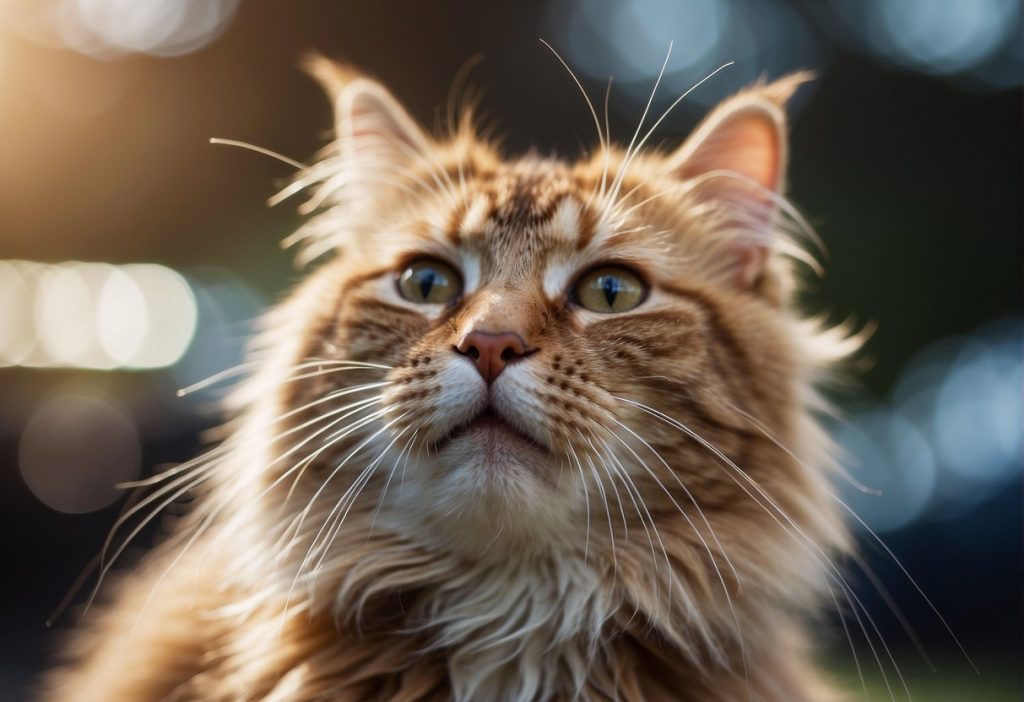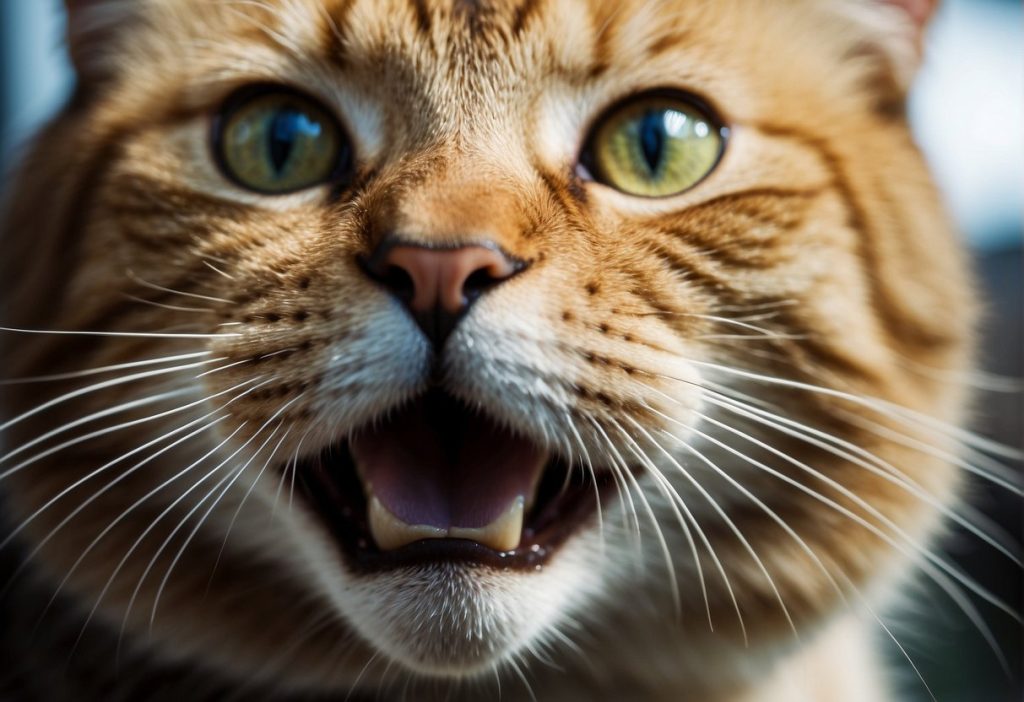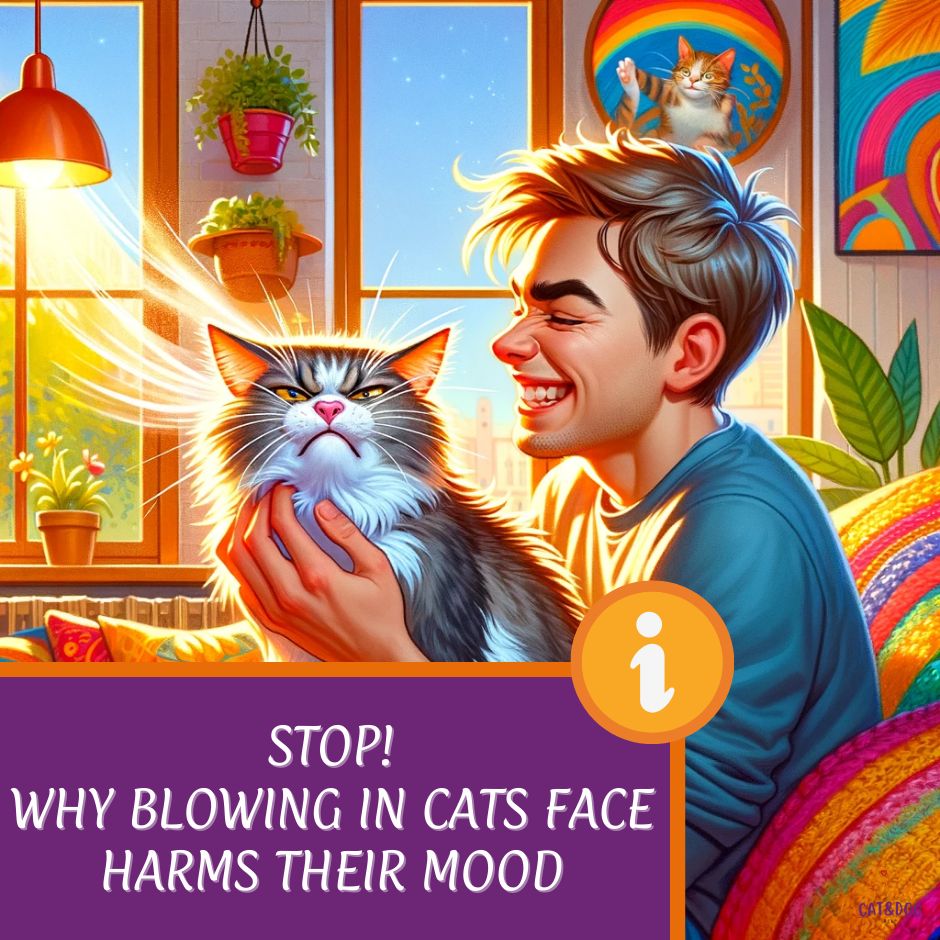When was the last time you noticed your cat’s detailed reaction to your actions, especially when it comes to the curious case of “blowing in cats face”?
You might’ve observed that cats possess a fascinating array of quirky behaviors and responses. But, what unfolds when you gently blow in their face?
Much like us, cats can find certain sensations either pleasant, neutral or downright irritating.
A cat’s face, adorned with sensitive whiskers, can detect the slightest change in their environment, making any unexpected flow of air potentially unsettling.
The bottom line is, that while some cats may react negatively to “blowing in cats face,” it’s important to remember that each cat is an individual, and their reactions can widely vary.
After all, cats will be cats, always ready to keep us on our toes or entertain us with their delightful and sometimes silly antics.

Consider their whiskers like little mood antennas, gauging and relaying information back to their feline brains about their surroundings.
When humans blow into a cat’s face, some might see it in jest, as a way to play or perhaps as a test of the cat’s reflexes, just like a human does.
However, this action can also be interpreted as a quick lick on the head, a social cue among cats that communicates trust and friendship.
But what’s going on in your cat’s head when your breath meets their snout? Well, insights into feline behavior suggest that it’s not all amusing for them.
Cats value their personal space, and an unexpected puff of air could infringe upon that comfort zone, especially if it’s accompanied by a sense of smell that they find unpleasant, just like a human does.
Their body language will let you know just how they feel about it, with swift turns of the head or maybe even a paw swipe to tell you to back off.
Cats have an incredible sense of smell, with 300 million olfactory receptors in their nose, making it 10,000 times more accurate than humans, so it’s no wonder they might find the smell of your breath unpleasant. (1)
However, there are other ways to show your cat affection, such as giving them some fussing and brushing, which they may appreciate more than a puff of air in their face.
Let’s delve into what makes this such a contentious topic among pet owners.
Opinions are split, with some thinking it’s a harmless way to engage with their pets, while others view it as a form of stress or aggression communication—akin to how cats might hiss to ward off others.
Through extensive research and caring for our fur pals, we’re able to provide something cat owners worldwide will love.
It’s important to consider your cat’s perspective and avoid any aggressive acts, such as blowing in their face, that may cause them discomfort or stress.
This conversation tiptoes the line of ethical pet care, respecting your cat’s boundaries, and promoting a positive and stress-free environment for your furry companion, from the cat’s perspective.
Key Takeaways
- Blowing in a cat’s face may trigger discomfort due to their sensitive whiskers.
- Cats communicate discomfort through body language which should be respected to avoid causing them anxiety.
- This practice is controversial and opens discussions on responsible pet ownership and awareness of animal welfare.
Blowing in Cats Face Are Ethical Considerations and Animal Welfare

You might think it’s a bit of harmless fun, but let’s paw-se for a moment. Have you considered how your feline friend feels about it?
Blowing into a cat’s face can stir up a whisker of debate among cat lovers. Some may see it as a playful interaction, but it taps into a deeper ethical conversation.
It’s not just about a puff of air; it’s about respect and kindness towards our pets.
Animal Welfare Organizations’ Viewpoint:
- Respect: Treat them with dignity. Animals, just like us, deserve to feel safe and snug.
- Dignity: Avoid acts that could cause distress or discomfort.
Fun Fact: Did you know that cats have an estimated 200 million scent receptors in their nose? Imagine that blast of breath amplified!
Instead of a gusty greeting, why not try these positive and engaging alternatives?
- Interactive Toys: Cats love to pounce and prey. It’s not just play—it’s their way of simulating the hunt!
- Puzzle Feeders: A delightful way to get their brain buzzing and belly full.
- Gentle Petting: Ah, the purr-fect way to bond. Most cats adore a good chin or ear scratch in their favorite spot.
Veterinarians and feline experts wave the green flag for these activities. They not only cater to natural cat behaviors but also deepen your bond without running the risk of causing any whisker worry.
So, next time you’re tempted to play a breathy prank on your cat, remember that their comfort is key. And who knows, switch up the game and you might just become your cat’s favorite two-legged companion!
Scientific and Behavioral Insights

You might think it’s just a funny trick, but let’s dig into what science says about this quirky human behavior and its effects on our feline friends.
What Research Says About Blowing in Cats’ Face While there isn’t a wealth of direct studies focusing on the reaction of cats to having their faces blown on, we can glean some insights from related research on feline stress signals and discomfort. Here’s a quick rundown:
- Cats can have complex facial expressions involving movements like lip parts, blinks, and ear positions.
- Blowing air can cause emotional responses, which might not be positive.
Case Study Consider a casual observation; a cat faced with an unexpected puff of air often squints turns away, or even jumps back.
Such actions can catch them off guard, potentially leading to increased stress levels.
Expert Opinions Veterinarians and animal behaviorists generally agree that it’s best to avoid startling your pet. For instance, one expert might say,
“Cats value their personal space, and an unexpected gust of your breath could be more intrusive than affectionate.”
Here’s a simple takeaway: While you might find their reactions amusing, consider whether it’s worth potentially causing your pet stress.
- Startling Your Cat: Not endorsed by experts.
- Respecting Boundaries: Encouraged for a happy cat.
In the end, understanding your cat’s boundaries and comfort levels is key—blowing in their face might just cross the line.
Practical Advice for Cat Owners

Safe and Enriching Interactions
Ever wondered if your cat likes that quirky game you invented? Cats have personalities as varied as ours, I kid you not. So, read their signals like you would a friend’s:
- Tail up and purring? A green light for fun! (2)
- Ears flat and hissing? Time out, they’re saying, “Not now, thank you!”
Introducing new toys? Do it bit by bit. Start with showing the toy, let your cat sniff it—cats love a good sniff—and watch for a curious sparkle in their eyes before moving it around for a chase.
Take it slow, and they’ll show you the pace they prefer.
For New and Prospective Cat Owners
Bringing home a new cat? Awesome! Let’s whip up a Checklist for a cat-friendly home:
Now, here’s a quick Do’s and Don’ts to ease into those first weeks:
- Do: Serve meals at the same time daily. Cats dig routine!
- Don’t: Flood them with affection. Let your new pal come to you.
Your first weeks together will set the tone for your relationship, so remember, patience is not just a virtue; it’s the secret ingredient for a long-lasting cat-ship!
Content Creation and Social Responsibility
It’s no secret that videos featuring our feline friends blowing up the internet come with their fair share of chuckles.
But, have you ever paused to consider the message those giggles might send?
Guidelines for Responsible Pet-Related Content Remember, behind every viral cat video, there’s a real, whiskery face with its likes and dislikes. Let’s talk about the impact such content can have:
- Viewer Perceptions:
When a cat’s reaction to having air blown in its face becomes a meme, does it change the way you think about cat care? It could. - Animal Treatment:
A cute annoyance on screen might translate to uncomfortable scenarios for cats off-screen. (5)
Consider this:
What if, instead of just laughs, these viral videos also slipped in a nugget or two of pet care wisdom?
Balancing Entertainment and Ethics
Yes, funny cat antics are a sure-shot way to brighten anyone’s day, but where do we draw the line? You can create engaging content that’s also a force for good:
- Case Study:
Look at content creators who sprinkle humor with educational tidbits. They’re golden examples of how to nail the balance.
Think of it this way—every piece of content you create or share is a chance to be responsible and respectful toward our furry companions.
So next time you’re filming your kitty for that potential viral hit, ask yourself: “Is this in good fun for both my viewers and my cat?”
Additionally, consider leaving the TV on for your cat while you’re away to provide them with some entertainment and stimulation, as well as a form of positive reinforcement for good behavior such as using their scratching post.
Just be sure to choose a channel that is animal-friendly, such as an outdoor channel or Animal Planet.
This small action, using the TV as a form of enrichment, can make a big difference in preventing boredom and destructive behavior in your cat, such as scratching furniture.
The first step in being a responsible pet owner is considering the well-being of your cat in all aspects of their life, including their entertainment and enrichment.
By considering these factors, you’ll not only entertain your audience, you’ll educate them too—now that’s something worth purring about, isn’t it?
Quick Recap

Cat Reactions
Most cats are not fans of having air blown on their faces. Their reactions can range from mild annoyance to outright fear or aggression.
Startle Reflex:
Similar to humans, an unexpected puff of air can cause a startle reflex. For some cats, this could be a mere flinch, while others might scurry away.
Negative Associations:
Over time, this can lead to negative associations with the action. It’s like the feeling you get when someone splashes cold water on you unexpectedly – not very pleasant, right?
Health Effects
What about smoke? It’s clear-cut: Just as secondhand smoke is harmful to humans, it’s even more dangerous to your cat’s health.
Full-spectrum marijuana, or any smoke blown toward them, can cause respiratory problems and distress.
Ethical Considerations:
It’s crucial to remember that what’s ‘cute’ or ‘funny’ to us might not be ethical.
Respectful pet ownership means ensuring your cat’s physical and emotional well-being is never compromised for a laugh or a viral video.
What Can You Do? Adopt ways to interact with your cat that promote mutual enjoyment. You know your pet best, so create an environment where both of you can thrive.
Play with them, give them affection, and always be mindful of their preferences and comforts.
Remember, cats are not just pets; they’re companions.
Each interaction with your feline friend is an opportunity to strengthen your bond, so let’s make each moment count in the kindest way possible.
Frequently Asked Questions
When it comes to playing with your feline friend, knowing the dos and don’ts is crucial for their well-being and your bond. Let’s tackle some of the most pressing questions you might have about interacting with your cat.
Is blowing in a cat’s face harmful?
You might think it’s just a bit of harmless fun, but blowing air into your cat’s face can be more disturbing than you realize.
It can startle them or, worse, cause stress or anxiety.
How can I tell if my cat is stressed?
Keep an eye out for signs like hiding, aggression, or changes in eating and grooming behavior.
If your cat’s tail is puffed up or they’re hissing, it’s a clear signal they’re not having a great time.
What are some safe ways to play with my cat?
Engage in activities your cat naturally enjoys, like chasing laser pointers or feather toys, which mimic their predatory instincts without causing them any discomfort.
Can blowing in a cat’s face affect our relationship?
Your cat might start to associate you with the unpleasant experience, leading to a less trusting and more distant relationship.
Why do cats dislike having air blown in their face?
It’s similar to how you might react to an unexpected breeze on a chilly day – it’s startling and uncomfortable.
Cats have sensitive whiskers and noses, making the sensation even more potent.
What should I do if I’ve accidentally stressed my cat?
Give them space to cool off and approach you on their terms. Ensure they have a safe hiding spot and consider using calming pheromones to help them relax.
What alternatives to blowing in a cat’s face can I use to get their attention?
Try soft clicking sounds, gently calling their name or a light tap on the floor. These methods are far less invasive and just as effective.


